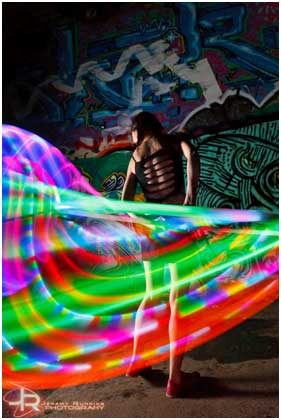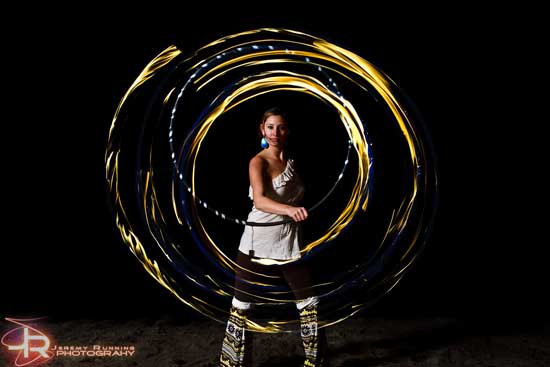LED Hula Hoopers and Fire Hoopers Show Physics in a Whole New Light

Haven Wheelock dances with a hoolahoop lit by LEDs Photo courtesy of Jeremy Running.
What does dancing have to do with physics? One photographer, Jeremy Running, uses his understanding of light and technology to capture two often underground types of dance, fire dancing and hula hooping, which inadvertently reveal different forces in physics and the nature of light. Running explains his photography by saying, "I was a child with a fascination with the power to stop time, and an intense draw to technology. As an adult, my love for photography allows me to combine the two in a creative and artistic manner, pausing time and light forever."
In the images that Running photographed, he may have paused an instant in time, but as the photographs show, in that instant, light is still traveling. When a photographer takes a picture his or her camera shutter opens and closes quickly, so quickly that most motion appears to stop when the picture is developed or, in the age of the digital camera, appears on the screen. Light travels much faster than the shutter can open and close, therefore allowing the camera to capture where the light has been in the time that the shutter was open. Light travels at 3x108 m/s , whereas a camera's shutter speed can reach as fast as 1/8000 of a second, meaning that it stays open for one eight thousandth of a second, which is still really fast, but during that time light could travel 37,500 meters which is about 23 miles, 3.2 miles shy of a marathon. Next time you take a picture, find a dark place with a pin point light (LEDs work great), and either moved the light or move the camera when you are taking a picture of the light. When you look at the picture, you should see trails that tracked where the light was in relation to the camera lens. Running does the same thing, but instead of random trails of light, Running captures the movement of that light through the movements of the dancers or hula hoopers.
Now, don't expect that you will see the length of a marathon in a trail of light if you do this, but what you will see is the path that the hula hoop took while it appears to defy gravity and gyrate around the dancer's hips. Torque, friction, and inertia all play a role in keeping the hula hoop from falling to the ground. Torque is sometimes described as the turning force, the force that keeps an object spinning. In the case of a hula hoop the torque is the force initiated by the dancer that pushes the hula hoop in a circular motion, created through pushing against the side of the circle which causes it to rotate. Friction is the force that is created when objects come into contact. Friction resists motion. In the case of the hula hoop, the dancer's hips come into contact with the hula hoop, which keeps the hoops from falling down, allowing the dancer to continue to exert torque on the hoop. Friction is also the force that is the push that makes torque possible. Another factor to consider is Newton's first law of motion, inertia, which says that an object in motion wants to stay in motion. In the case of the hula hoop, once it has started revolving around the dancer's hips, it wants to continue moving. According to this law of motion, mass plays an important role. Objects of greater mass have more inertia than those with less mass; therefore, more massive or heavier hula hoops are easier to keep in motion than lighter, less massive hula hoops. The dancers manipulate the force of gravity through torque, friction, and inertia to keep a hula hoop gyrating around their hips, arms, legs, and hands, creating beautiful patterns that are art.

Kali Deno hoops with fire
Photo courtesy of Jeremy Running.
For more information:
http://www.mir.com.my/rb/photography/fototech/apershutter/shutter.htm
http://www.youtube.com/watch?v=ZGK770HE7os
http://www.jeremyrunning.com/about











